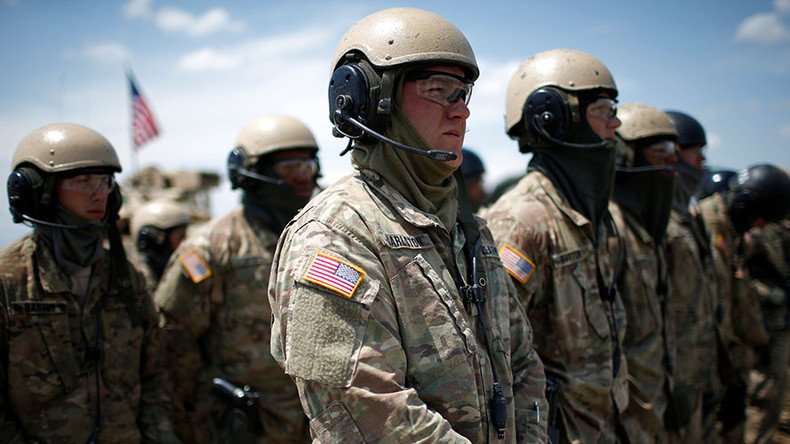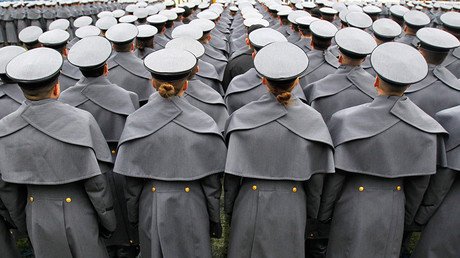‘You can’t buy your way out’: Military bureaucracy causing skilled service members to leave – report

After President Donald Trump proposed a $54 billion increase in military spending, a new report suggests that money will not fix fundamental problems that have existed since the Cold War ended.
A report released Monday by the Bipartisan Policy Center (BPC) says that the current system of recruiting, training and retaining military personnel is a “holdover from the Cold War, reflecting the national security priorities and American society of that time.”
READ MORE: Over 33mn US employees, including military personnel, had their data hacked
After World War II, when the Soviet Union was the only major threat to the US, defense leaders created the “one-size-fits-all” system to ensure that the armed forces would “remain ‘young and vigorous’ enough to meet the physical demands of battle but also retain a large number of midgrade officers and NCOs prepared to command units in case of another major war.”
The BPC says that the system helped win the Cold War, however, is no longer working in the current environment.
Republicans introduce bills authorizing new military force against #ISIShttps://t.co/ZySbIQfaBupic.twitter.com/dsDzK4KMxo
— RT America (@RT_America) March 16, 2017
“The military uses a 70-year-old ‘one-size-fits-all’ personnel system that brings young people into the military in their teens and 20s, puts them into a rigid command-and-promotion structure, and removes all but the most-senior-ranking service members by their early 40s,” the BPC found.
BPC determined the status quo caused an unsustainable growth of personnel costs and discouraged prospective candidates with new skills from joining, while also “favor[ing] uniformity over individual merit” and discharging personnel at their peak.
Part of the problem, the report says, comes from thoughtlessly throwing money into a bureaucracy. Since 2001, the cost of military personnel has increased by more than 50 percent. However, during that time, the Army lowered recruiting standards, the Air Force saw lower retention with pilots, and service members from all branches have reported a stagnant satisfaction with military life.
Instead, the report suggests creating a more sustainable military system that entices Americans to serve.
"You can’t buy your way out of this problem, and we’ve been trying to buy our way out of the problem with bonuses and all the other things,” former defense secretary Leon Panetta, co-chair of the BPC study team, told Breaking Defense. “Frankly that’s why personnel costs have gone up 50 percent in the last 15 years.”
The report claims that “one-size-fits-all” system that is trapped in the past and “needs to be updated to one that fully engages all of American society, adapts to new threats, is sustainable over the long term, and is technically proficient.”
To adapt to the rising new threats, the report says the military needs to recruit service members with specialties ranging from cybersecurity to translators. To achieve this, it calls on lawmakers to implement 39 policy proposals to create a Fully engaged, Adaptable, Sustainable, and Technically proficient (FAST) military.
Some of the BPC suggested reforms include requiring every young American to take the military’s Armed Services Vocational Aptitude Battery (ASVAB) test, which would assess an individual’s critical skills. At the moment, the Selective Service registration is only filled out by men and only assesses basic information.
The BPC also suggests creating a “smart draft” that would be gender-equal, bringing women into the draft. Along with the proposed ASBA test, the military would have a massive database that could be quickly accessed in times of need.
Military spouses would also be able to more easily sustain a career when relocating and improve their access to quality child care services. Many service members become “geographic bachelors and bachelorettes,” due to forced relocation of one member of a family.
A pilot program is recommended that allows service members to have more influence over their future assignments and travel options. At the same time, it would give commanders greater input in staffing decisions, allowing them to pick the members that would be best suited for future missions.
Targeted for removal is the “up or out” system, which ensures turnover by kicking service members out if they are not promoted quickly enough. The BPC suggests replacing it with a “perform-to-stay” system based on merit, performance and experience.
The report calls for specialized recruiting offices to focus on critical skills and allow mid-career civilians to enter the military at higher ranks. An online marketplace would also be created so that commanders could post jobs and rank their favorite candidates, while applicants would be allowed to search and rank their preferred jobs.













